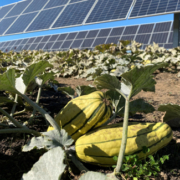Fact Sheet: Making the Case for Crops + Solar
By Stacie Peterson, PhD, NCAT; and Heidi Kolbeck-Urlacher, Center for Rural Affairs
March 2024
Agrisolar practices, also called agrivoltaics, are the co-location of agriculture and solar within the landscape. They include solar co-located with crops, grazing, beekeeping, pollinator habitat, aquaculture, and farm or dairy processing. Agrisolar practices offer an opportunity to allow solar and agriculture to co-exist while meeting demands for clean energy and resilient rural infrastructure. One agrisolar approach is crop production under and adjacent to solar photovoltaics. Farms and research sites across the country demonstrate agrisolar as an opportunity to diversify farm revenue, decrease crop irrigation, increase crop yield, increase soil moisture, improve solar panel efficiency, and increase rural energy independence (Barron-Gafford, 2019; MacKnick, 2022; and Adeh, 2019).
Extreme heat and weather events from climate change, including the long-term drought in the American west, have led to water shortages, decreased crop yields, and increased heat stress for farm workers. Climate projections show this trend continuing, resulting in a marked decrease in crop yield in the future (Hsiagn, 2017). At the same time, an increasing population has elevated the need for nutritious local foods and food sovereignty.



